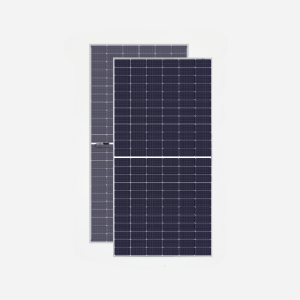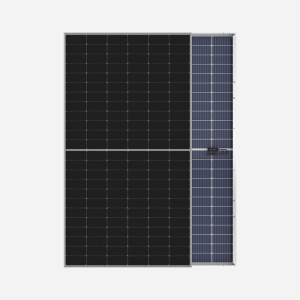India is transitioning its focus to renewable energy, and solar power is becoming more and more vital to the nation as it transforms to cleaner energy. With technological progress, double-sided solar panels or bifacial solar panels are becoming more sought after since they can generate power from both sides. They are more efficient, better performing, and longer-lasting than standard monofacial solar panels.
Here we will be talking about bifacial solar panels, their cost, efficiency, pros, and future in India.
What Are Bifacial Solar Panels?
Double-sided solar panels or bifacial solar panels are designed to generate electricity on both the front and rear sides. While traditional solar panels trap sunlight on a single side, bifacial panels are able to capture reflected light from the ground, water, or other surfaces, contributing to their overall energy output.
Major Characteristics of Bifacial Solar Panels:
- Dual-sided power generation for higher efficiency.
- Glass-glass or transparent backsheet design for improved durability.
- More energy produced than regular solar panels.
- Suitable for large solar farms, commercial roofs, and water-based solar installations.
How Do Bifacial Solar Panels Work?
Bifacial solar panels function exactly the same as monofacial panels but with a twist—both the front and back of the panels generate electricity.
Working Principle:
- Front Side Absorption: The front side absorbs direct sunlight, similar to normal panels.
- Rear Side Reflection: The back side gathers light that reflects from surrounding surfaces.
- Increased Energy Production: Bifacial panels are able to generate 10-30% more energy than conventional panels by utilizing both direct sunlight and reflected sunlight.
The performance of bifacial solar panels in India is significantly affected by ground reflectivity (albedo effect). Surfaces like white-painted rooftops, sand, water, and concrete enhance the efficiency of bifacial panels by reflecting more sunlight onto the rear surface.
Advantages of Bifacial Solar Panels in India
India gets around 4-7 kWh of solar radiation per square meter per day. This is a great place for bifacial solar panels. Some of the most important benefits are as follows:
1. Higher Efficiency and More Energy Output
- Bifacial panels are contributing 10-30% additional power to monofacial panels.
- They work well in open spaces that reflect a lot of light, including deserts, lakes, and white roofs.
2. Improved Performance under Poor Weather
- Less heat absorption: Glass-glass design minimizes overheating, with better performance in the tropics.
- More durable: Bifacial panels are resistant to dust, heavy rain, and high winds—the common weather conditions in India.
3. Faster Return on Investment (ROI)
- Though bifacial solar panel prices are higher than monofacial panels, their increased energy production leads to faster ROI.
- The Levelized Cost of Energy (LCOE) is less, indicating that the unit price of electricity is less in the long run.
4. Ideal for Large-Scale and Commercial Installations
- Indian solar farms (Gujarat, Rajasthan, Tamil Nadu) can achieve their maximum efficiency through bifacial technology.
- Industrial and commercial roofs can benefit from the high reflectivity of concrete surfaces.
- Floating solar installations (Maharashtra, Kerala) can utilize water reflectivity to enhance panel efficiency.
5. Government Support and Incentives
The Indian government actively promotes solar energy through:
- PM Surya Ghar Muft Bijli Yojana – For more visit Official Website
- The Pradhan Mantri Kisan Urja Suraksha evam Utthaan Mahabhiyan (PM-KUSUM) Scheme – Visit Official Website for more information.
Disadvantages of Bifacial Solar Panels
Despite their advantages, bifacial solar panels have some drawbacks:
1. Higher Initial Cost
- Bifacial solar panel prices are generally 15-20% higher than monofacial panels due to their advanced materials and manufacturing process.
2. Need for Reflective Surfaces
- Bifacial panels work optimally if mounted on reflective surfaces such as white-painted roofs, sand, or water.
- When used on dark or non-reflective surfaces, the back side efficiency can be less.
3. Installation Complexity
- The right tilt angle and mounting height are paramount to reflect the light perfectly.
- Professional installation is recommended to achieve maximum efficiency.
Bifacial Solar Panels vs Monocrystalline Panels
Both bifacial and monocrystalline solar panels are highly efficient options, but they have key differences:
| Features | Bifacial Solar Panels | Monocrystalline Solar Panels |
| Power Generation | 10-30% higher due to dual-sided power absorption | Standard energy output |
| Efficiency | 20-25% (depending on reflectivity) | 18-22% |
| Price | Higher upfront cost | Lower cost |
| Durability | More durable (glass-glass structure) | Standard durability |
| Best Use Cases | Large solar farms, floating solar, commercial rooftops | Residential rooftops, small-scale projects |
Which One Should You Choose?
- If you have a large open area or highly reflective surface, bifacial panels provide better efficiency and ROI.
- If you are looking for a cost-effective solution for a small residential installation, monocrystalline panels might be a better option.
Bifacial Solar Panel Price in India
The price of bifacial solar panels in India varies depending on brand, efficiency, and installation costs.
Estimated Bifacial Solar Panel Price in India (per watt):
- ₹30 – ₹45 per watt (without installation).
- ₹50 – ₹70 per watt (including installation, inverter, and accessories).
Factors Affecting Bifacial Solar Panel Prices:
- Brand & Manufacturer – Tier-1 manufacturers are higher in cost but provide higher efficiency and warranty.
- Panel Wattage & Efficiency – More efficient panels are more expensive but produce more power.
- Installation Location – Prices differ depending on mounting structure, labor, and location.
Future of Bifacial Solar Panels in India
With solar technology improving and prices going down, bifacial solar panels will become cheaper and more popular in India.
Key Trends to Watch:
- Falling Prices: Increasing production will make bifacial panels more affordable.
- Improved Mounting Systems: Improved designs will increase rear-side light absorption.
- Increased Utility-Scale Adoption: More utility-scale solar parks will adopt bifacial technology.
Conclusion
Bifacial solar panels are a great investment for India‘s solar sector, with greater efficiency, longevity, and performance. Although they have a higher initial cost, their higher energy output and reduced LCOE make them a wise long-term investment.


